
Lammana Priory was a priory on Looe Island in Cornwall, UK, consisting of two Benedictine monks until 1289. It was owned by Glastonbury Abbey and the property was sold in 1289 to a local landowner. [1]

Lammana Priory was a priory on Looe Island in Cornwall, UK, consisting of two Benedictine monks until 1289. It was owned by Glastonbury Abbey and the property was sold in 1289 to a local landowner. [1]
The Priory of St Michael of Lammana was a possession of the Benedictine monastery of Glastonbury Abbey during the Middle Ages. It consisted of two chapels; one on the top of Looe Island, and another chapel directly opposite on the mainland. A third building known as the Monk's House, located 150 yards down the hill from the mainland chapel, was the monks living quarters. It also had a refectory for pilgrims who came to visit the island for Michaelmas.
The earliest documentary evidence for the existence of the priory is a papal confirmation of Pope Lucius II in 1144. [2] The confirmation (Privilegium) was made during the abbacy of Bishop Henry of Blois, the brother of King Stephen.
Some sixty years later, (c. 1200) we have the charter of Hasculf de Soleigny, the lord of the manor of Portlooe, granting to the Church of the Blessed Virgin Mary of Glastonbury ... the Island of St Michael of Lammana, with all its appurtenances, lands, and tithes which they have held abantiquo, 'from of old.'
Although not strictly a parish, it consisted of approximately 297 acres of tithe lands which ran from the edge of St Nicholas Church in West Looe, up West Looe Hill as far as the junction of Talland Road and then southwards to the manor of Portlooe, and downstream to a field known as Old Mills.
The ownership of tithes were the matter of a long-standing dispute with the Augustinian canons of Launceston Priory, who acquired the parish of Talland early in the 13th century.
In about 1240–50, Earl Richard of Cornwall granted permission for Glastonbury to lease out the manor of Lammana, and on the 24 June 1289, the patronage of the island chapel was sold to Walter of Treverbyn, lord of Portlooe.
The dispute over ownership once again returned, and Walter was forced to sue Launceston Priory for damages amounting to £40. [3] In October 1290, the Sheriff of Cornwall was instructed to form a jury of twelve local men, who returned a verdict at the Court of Common Pleas, Westminster, in favour of Walter.
The chapels remained in use up until the Dissolution of the Monasteries in the reign of Henry VIII in mid-sixteenth century. Eventually they fell into disrepair, and by the mid-nineteenth century, apart from a few visible walls, became ruins.
The mainland chapel was excavated in 1935 and 1936, by Charles Kenneth Croft Andrew, antiquarian and archaeologist, with the support of his friend the Rev. Henry Ardern Lewis, M.A., then Vicar of Talland, and Mr C.B. Willcocks, F.R.I.B.A., F.S.A.
Croft Andrew's excavations were re-evaluated in 1994 by Dr Lynette Olson, senior lecturer of History at Sydney University, along with Cathy O'Mahoney, Ann Preston-Jones and Peter Rose. [4]
In 2008 Channel 4's archaeology series Time Team carried out excavations on Looe Island and the mainland. Wessex Archaeology were commissioned to record finds and evaluate the archaeological context.
Post archaeological assessment
Looe Island
The evaluation concluded that there was 'no definitive evidence for prehistoric activity on either site.' [5] A large stone buried in the grounds of Island House may have been prehistoric, but the absence of a socket indicated that it had been removed from another location on the island. Romano-British (AD 43-410) pottery was found in two ditches, and a small hoard of eight Roman coins dating between AD 253–330. The latest of these coins was a 'camp gate' issue of the House of Constantine the Great (d. 337). There was a single phase of construction of the chapel with the addition of a buttress to the south west corner of the nave in the 13th century. An inhumation burial was found underneath the area of the chancel arch, with a second burial outside the southern wall of the chapel. Neither burials could be securely dated. Pottery in the upper fill of the chancel burial was dated as 15th or 16th century.
Mainland Chapel
Wessex Archaeology confirmed the 1930s ground plan consisting of a nave and chancel with a south facing porch, and a second entrance to the north of the building. There was evidence of a rood screen in front of the chancel arch. The rood screen separated the nave from the chancel. Access to the chancel was restricted to the priest or chaplain in charge, for marriages, and for lords of the manor who usually held the advowson. [6] One inhumation burial in situ was found in the south east corner of the chancel. A stone lined reliquary was found in the central area of the chancel. Reliquaries contained items deemed too precious to display inside the church, such as holy relics, or the bones of the saint who founded the site. A radio carbon date of a humerus taken from the inhumation burial produced a date range of AD 1200–1280. The skeleton was that of an adult male aged between 35 and 55, with an approximate height of 5 feet 4 inches tall. Wessex Archaeology concluded that the foundation date of the mainland chapel remains unknown.
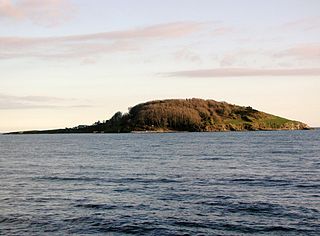
Looe Island, also known as St George's Island, and historically St Michael's Island is a small island nature reserve a mile from the mainland town of Looe off Cornwall, England.
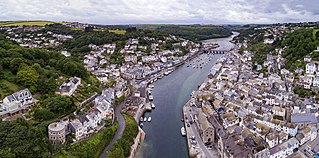
Looe is a coastal town and civil parish in south-east Cornwall, England, with a population of 5,280 at the 2011 census.

Glastonbury Abbey was a monastery in Glastonbury, Somerset, England. Its ruins, a grade I listed building and scheduled ancient monument, are open as a visitor attraction.
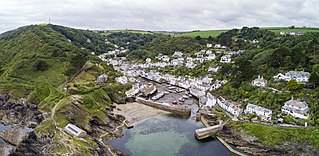
Polperro is a large village, civil parish, and fishing harbour within the Polperro Heritage Coastline in south Cornwall, England. Its population is around 1,554.

Tywardreath is a small hilltop village on the south coast of Cornwall, England, United Kingdom, about 3 miles (5 km) north west of Fowey. It is located in a sheltered spot overlooking a silted up estuary opposite Par and near the beach of Par Sands. It is on the Saints' Way path.

The hundreds of Cornwall were administrative divisions (hundreds) into which Cornwall, the present day administrative county of England, in the United Kingdom, was divided between c. 925 and 1894, when they were replaced with local government districts.

Boyton is a civil parish and village in Cornwall, England, United Kingdom. It is situated close to the River Tamar and the border with Devon about six miles (10 km) north of Launceston. According to the 2001 census it had a population of 378.This increased to 457 at the 2011 census.

Pelynt is a civil parish and village in Cornwall, England, United Kingdom. It is 20 miles (32 km) west of Plymouth and four miles (6.5 km) west-northwest of Looe. Pelynt had a population of around 1,124 at the 2001 census which increased to 1,296 at the 2011 census. In addition an electoral ward with the same name exists but extends towards Widegates avoiding Looe at all times. The population at the 2011 for this ward was 4,453.

St Enoder is a civil parish and hamlet in Cornwall, United Kingdom. The hamlet is situated five miles (8 km) southeast of Newquay. There is an electoral ward bearing this name which includes St Columb Road. The population at the 2011 census was 4,563.

East Wivelshire and West Wivelshire are two of the ancient Hundreds of Cornwall.

Werrington is a civil parish and former manor now in Cornwall, England, United Kingdom. Prior to boundary changes it straddled the Tamar and lay within the county of Devon. The portion on the west side was transferred to Cornwall in 1966. It is situated 1 mile (1.6 km) to the west of the Tamar, the traditional boundary between Devon and Cornwall, and 1 mile (1.6 km) north of Launceston.

South Petherwin is a village and civil parish in east Cornwall, England, United Kingdom. It is in the Registration District of Launceston. The civil parish is bounded to the north by the Launceston parishes of St Thomas and St Mary Magdalene, to the east by Lawhitton and Lezant parishes and to the west by Trewen parish. The population of the parish in the 2001 census was 932. The district falls in the Altarnun electoral ward but the population of the civil parish at the 2011 Census was almost unchanged at 931.

Lansallos is a village in the civil parish of Polperro in south Cornwall, England, United Kingdom. It is situated between Polruan and Polperro about 5 miles (8 km) east of Fowey in Liskeard Registration District.
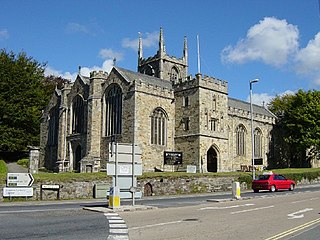
St Petroc's Church, Bodmin, also known as Bodmin Parish Church, is an Anglican parish church in the town of Bodmin, Cornwall, England, United Kingdom.

Talland Church is a Grade I listed building located on the cliff-top at Talland near Looe in Cornwall. It is dedicated to St Tallanus and was built by Augustinian monks from Launceston.
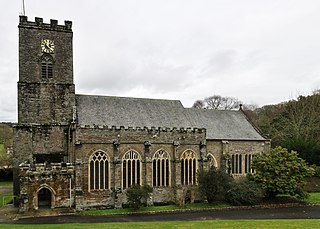
Christianity in Cornwall began in the 4th or 5th century AD when Western Christianity was introduced into Cornwall along with the rest of Roman Britain. Over time it became the official religion, superseding previous Celtic and Roman practices. Early Christianity in Cornwall was spread largely by the saints, including Saint Piran, the patron of the county. Cornwall, like other parts of Britain, is sometimes associated with the distinct collection of practices known as Celtic Christianity but was always in communion with the wider Catholic Church. The Cornish saints are commemorated in legends, churches and placenames.

St Giles on the Heath, sometimes hyphenated as St Giles-on-the-Heath, is a village and civil parish in the far west of Devon, England. It forms part of the local government district of Torridge. The village is in the east of the parish and lies on the A388 road about eight miles south of the town of Holsworthy.
Presented below is an alphabetical index of articles related to Cornwall:
Henry Ardern Lewis was a Church of England minister and Cornish Bard. He was known for several publications during the 1930s dealing with the legends of Joseph of Arimathea and Glastonbury Abbey.